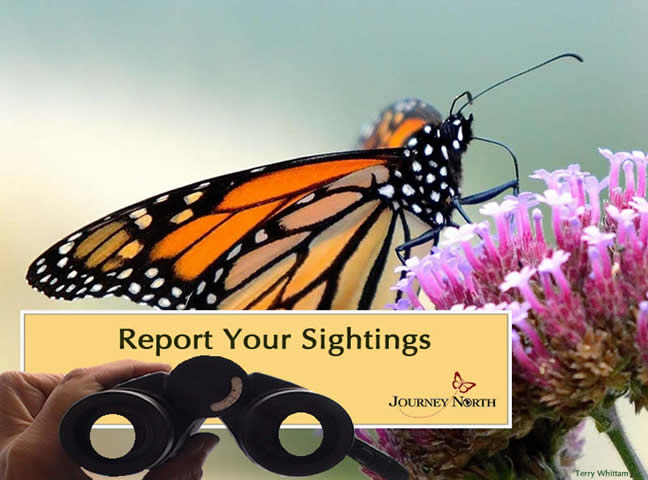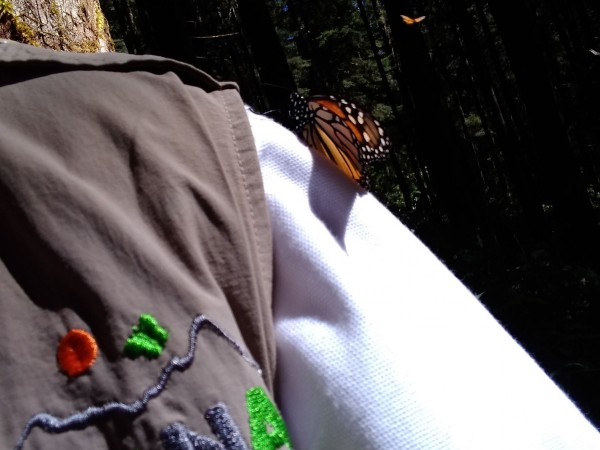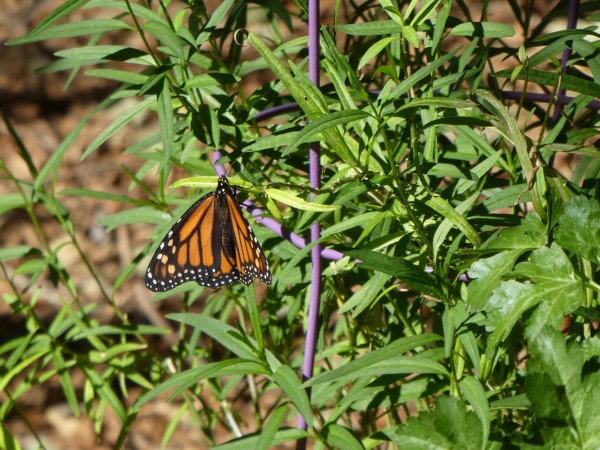Signs of Migration
Special Letter from Karen Oberhauser: Monarch Winter Numbers Are In – A Decline of 26%
In a special letter, Karen Oberhauser, director of the UW–Madison Arboretum and a leading monarch expert, discusses new data that shows the decline of monarchs overwintering in Mexico. Dr. Oberhauser writes, "I have been studying and working to conserve monarchs and their habitat for over 35 years. This announcement, while not unexpected based on the numbers that we saw in the Upper Midwest last summer, is a reminder that we can’t rest in our efforts to conserve monarchs."
Letter From Estela Romero: Leaving Soon?
At El Rosario and Sierra Chincua sanctuaries, Estela Romero senses monarchs may be on their way soon. And despite witnessing the overwintering season year after year, Estela still marvels at the sheer scale and beauty of it all. She writes, "The end of the overwintering season is imminent. Increasing temperatures over the weekend could accelerate monarchs’ departure . . . the remaining part of the colony has mostly spread around. Seeing them at the small meadow just by the Las Balsitas site is a sublime spectacle. They take up all the space in the air and cover the ground."
Read more of Estela Romero's Letter: Leaving Soon?
Leer más de la carta de Estela Romero: ¿Saliendo Pronto?
Letter From Ellen Sharp: Collaborative Clusters to Protect Monarchs
Reporting from Cerro Pelon Sanctuary, Ellen Sharp highlights the new data that shows the decline of monarchs overwintering in Mexico. And based off of her time and experience in Mexico, Ellen offer some thoughts on what has worked and what hasn't, and how this can aid progress moving forward. She writes, "After seven years of living at the entry of Cerro Pelon, I have some ideas about how Mexico’s existing conservation projects could be changed to more closely resemble collaborative monarch clusters rather than hierarchical beehives. But rather enumerating what’s not working, I’d like to talk about what is: La Comisión Estatal de Parques Naturales y de la Fauna, or CEPANAF."
Read more of Ellen Sharp's Letter: Collaborative Clusters to Protect Monarchs
Read more of Ellen Sharp's Letter: Collaborative Clusters to Protect Monarchs [Spanish translation]
Slideshow from Pato Moreno: Taking Care of Cerro Pelon's Forest
Pato Moreno is a State of Mexico Commission for Natural Parks and Fauna (CEPANAF) forest ranger and coordinator of Butterflies & Their People. Beyond his critical work of observing and safeguarding monarchs at Cerro Pelon, Mr. Moreno uses his photography and videography skills to create content for Butterflies & Their People. This week, he was kind enough to share a slideshow of images with Journey North that show the working life of the CEPANAF rangers and the Butterflies & Their People forest guardians.
Read Ellen Sharp's Introduction to Pato Moreno
View the Slideshow from Pato Moreno: Taking Care of Cerro Pelon's Forest
Letter from Gail Morris: Western Monarch Spring Report #1
Out West, Gail Morris reports on Monarch activity in California and Arizona. She also stresses the importance of reporting any monarch observations to Journey North. Gail writes, "This week monarch reports stretch from just south of San Francisco, California, down the coast and east into the lower deserts of Arizona . . . Don’t forget to report any monarchs you may be lucky to see! Do their wings look fresh and new or worn? A photo from your phone or camera can help us all see the world monarchs are exploring now early in the spring movement."
Read more of Gail Morris’ Letter: Western Monarch Spring Report #1
Report Your Observations
We have heard from many of our citizen scientists concerned about the extreme cold temperatures in Texas. With the decline in the population numbers for Eastern monarch butterflies, it is now more important than ever to report your observations.
Let us know when you observe your first migrating monarch using the reporting category: Monarch Adult (FIRST sighting).
Signs of Migration?
In mid-February, we received a flurry of first observations from locations about 100 km outside the Monarch Biosphere Reserve.
Oscar Alejandro Morales Juárez in Acámbaro, GUA: "A couple of butterflies flying aprox at 45 meters above grounf, cloudy, temperature 26°C 17:59 hours wind at 11 km/h they were flying from east to west." (02/22/2021; courtesy of Correo Real)
Then in March, we received a report from Tequisquiapan Municipality:
Naomi in Tequisquiapan, QUE: "Today at 4:30 central time I observed more than 20 monarchs flying over my garden in Tequisquiapan Mexico. They are feeding on coral trees, fresno blossoms and other plants in the garden." (03/02/2020)
Overwintering Monarchs
Did monarchs overwintering along the Gulf states survive the extreme weather? Since February 14th, only six reports have been submitted to Journey North reporting an adult monarch observation.
Elizabeth in San Antonio, TX: "I was so surprised to see the monarch that I barely had time to snap a photo of it as it floated through and over the live oak trees! I zoomed in to get a better image." (02/28/2021)
Milkweed and Nectar Sources
Perhaps more importantly, did milkweed and nectar sources survive the deep freeze? There are very few reports of milkweed emergence or other observations of monarch nectaring behavior. Please report these observations to Journey North.
Lane in San Pedro Garza García, NLE: "Just to let you know that the cold spell in Monterrey has set the milkweed around our house back -- maybe even killed it. We will have to wait and see what happens in the coming weeks, but right now, there are no leaves. Is this happening elsewhere?" (02/24/2021)
Fred and Kay in Burnet, TX: "Completely surprised to see a monarch. It was on the only thing blooming—a dandelion. There is a nearby flowerbed with at least 13 Antelopehorn Milkweed but those plants have not yet emerged." (03/02/2021)








